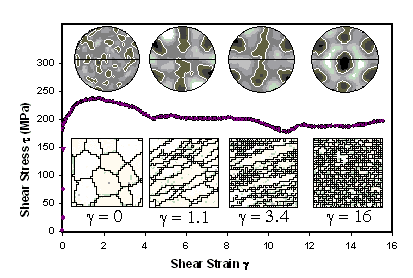

Magnesiowüstite is volumetrically the second most abundant mineral and is likely to be the weakest solid phase in the Earth's lower mantle. Its mechanical behaviour may have a significant influence on rates of convection, particularly in regions where high shear strains promote separation of phases into mechanically distinct layers, such as we observe in many mylonites. In these regions, strain may become localized in relatively narrow bands comprised predominantly of magnesiowüstite, resulting in development of textures that may be observable seismically.
In a series of tests in a high-pressure, high-temperature deformation apparatus ('Paterson rig'),
we investigated the deformation behaviour of magnesiowüstite (Mg0.8Fe0.2O)
in torsion at 1300 to 1400 K, 300 MPa confining pressure and strain rates
of 10-3 to 10-4 sec-1. Shear strains ( )
of up to 16 were achieved with this deformation geometry. Shear stress
vs. shear strain curves (Fig. 3.1-3) show only slight weakening of the
material after the initial yield. Strain rate stepping tests at various
shear strains indicate that the samples were deforming in the dislocation
creep regime in all experiments (see also Section 3.1b).
)
of up to 16 were achieved with this deformation geometry. Shear stress
vs. shear strain curves (Fig. 3.1-3) show only slight weakening of the
material after the initial yield. Strain rate stepping tests at various
shear strains indicate that the samples were deforming in the dislocation
creep regime in all experiments (see also Section 3.1b).
Microstructural and textural analysis with electron backscattering diffraction (EBSD) revealed that at low strains the original grains are strongly deformed and sheared (Fig. 3.1-3, lower row). With increasing shear strain the grain structure is refined by recrystallization. In the samples with low shear strains a network of subgrain boundaries with small misorientation angles (<10°) is formed. Increasing shear strain and recrystallization lead to an increase of the misorientation angle and the formation of grain boundaries. Therefore progressive subgrain rotation appears to be the dominant recrystallization mechanism leading to a decrease in grain size from ~40 µm in the starting material to ~8 µm in the completely recrystallized sample.
The textures (Fig. 3.1-3, upper row) for the low strain samples are similar to torsion textures of fcc metals, indicating that {111} played an important role as slip plane. With higher shear strains and increased recrystallization the texture pattern changes slightly. This is in agreement with a), the mechanical data, which show little weakening with increasing shear strain, and b), progressive subgrain rotation as the mechanism of dynamic recrystallization, because this mechanism causes only small modifications of the deformation texture. The formation of subgrains at these relatively low homologous temperatures (~0.4 Tm) is probably promoted by cross slip between the different slip planes ({100}, {110} and {111}), all of which have the same Burgers vector <110>.
 |
 = 16 at
1300K; the microstructure maps (lower row) and {111} pole figures (upper row) are from the starting
material, two samples deformed to a = 16 at
1300K; the microstructure maps (lower row) and {111} pole figures (upper row) are from the starting
material, two samples deformed to a  of 1.1 and 3.4 respectively and the
sample for which the stress-strain curve is shown; sections are perpendicular
to the horizontal shear plane and the shear sense is dextral. of 1.1 and 3.4 respectively and the
sample for which the stress-strain curve is shown; sections are perpendicular
to the horizontal shear plane and the shear sense is dextral. |
Overall, this work demonstrates that magnesiowüstite is a weak phase, at least at low pressures, and that even after deformation to high shear strains, a fairly complicated texture pattern is developed in the rock. Thus, if deformation of magnesiowüstite in the deep mantle occurs by this mechanism, it is unlikely that a strong seismic anisotropy due to the lattice preferred orientation will be observable, even in regions of high shear strain.

Tel: +49-(0) 921 55 3700 / 3766, Fax: +49-(0) 921 55 3769, E-mail: bayerisches.geoinstitut(at)uni-bayreuth.de
 Previous page
Previous page